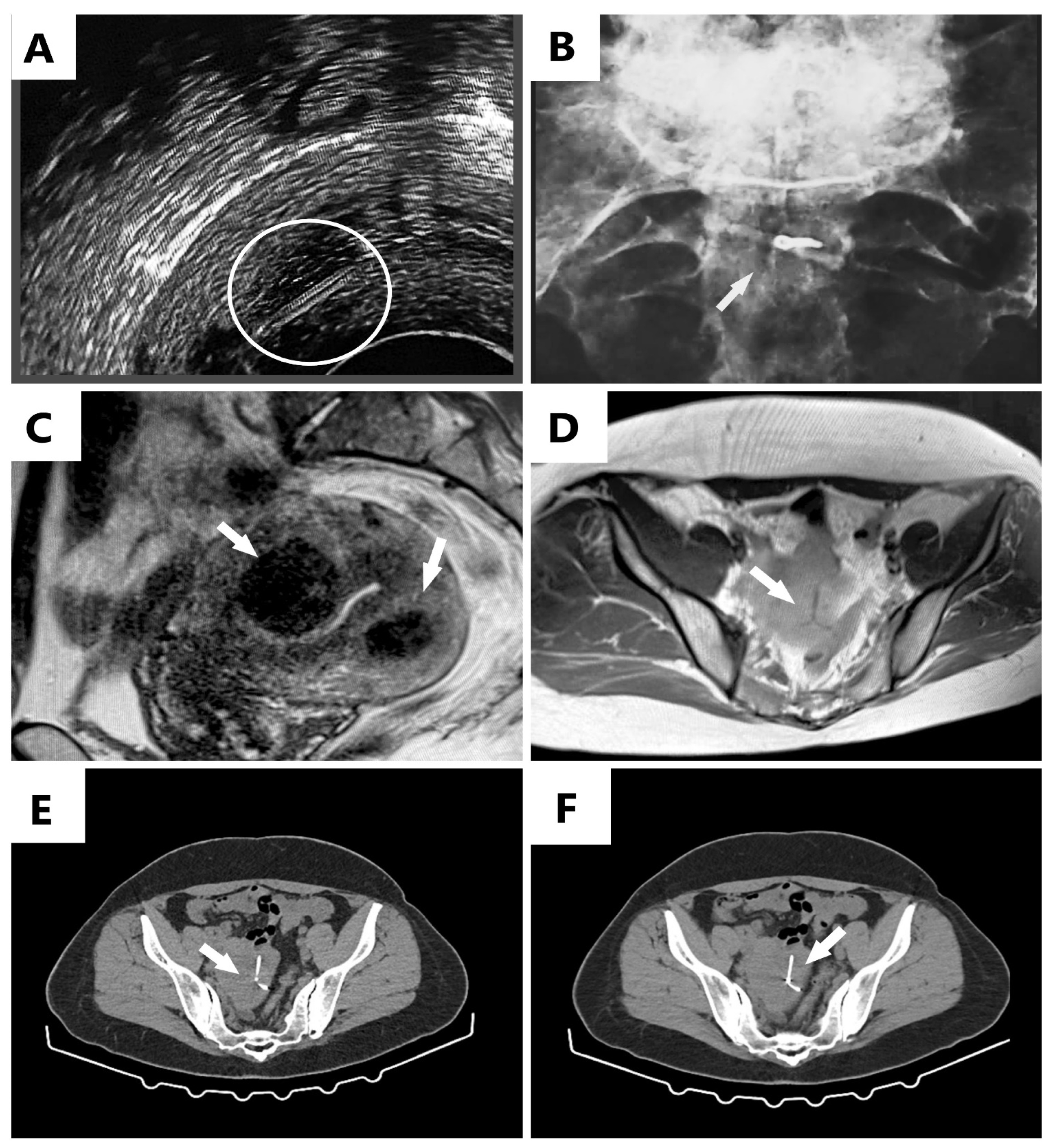An Interesting Image of Transmural Migration of a Levonorgestrel-Releasing Intrauterine Device (LNg-IUD)
Abstract

Author Contributions
Funding
Institutional Review Board Statement
Informed Consent Statement
Acknowledgments
Conflicts of Interest
References
- Tabatabaei, F.; Masoumzadeh, M. Dislocated intrauterine devices: Clinical presentations, diagnosis and management. Eur. J. Contracept. Reprod. Health Care 2021, 26, 160–166. [Google Scholar] [CrossRef] [PubMed]
- Akpinar, F.; Ozgur, E.N.; Yilmaz, S.; Ustaoglu, O. Sigmoid colon migration of an intrauterine device. Case Rep. Obstet. Gynecol. 2014, 2014, 207659. [Google Scholar] [CrossRef] [PubMed]
- Ayodele, A.; Oloruntobi, R. Perforation of the appendix and the sigmoid colon by an ectopic IUD. Int. J. Reprod. Contracept. Obstet. Gynecol. 2017, 4, 1618–1621. [Google Scholar] [CrossRef]
- Cheung, M.L.; Rezai, S.; Jackman, J.M.; Patel, N.D.; Bernaba, B.Z.; Hakimian, O.; Nuritdinova, D.; Turley, C.L.; Mercado, R.; Takeshige, T.; et al. Retained Intrauterine Device (IUD): Triple Case Report and Review of the Literature. Case Rep. Obstet. Gynecol. 2018, 2018, 9362962. [Google Scholar] [CrossRef]
- Goldstuck, N.D.; Wildemeersch, D. Role of uterine forces in intrauterine device embedment, perforation, and expulsion. Int. J. Womens Health 2014, 6, 735–744. [Google Scholar] [CrossRef]
- Weerasekera, A.; Wijesinghe, P.; Nugaduwa, N. Sigmoid colocolic fistula caused by intrauterine device migration: A case report. J. Med. Case Rep. 2014, 8, 81. [Google Scholar] [CrossRef]
- Mederos, R.; Humaran, L.; Minervini, D. Surgical removal of an intrauterine device perforating the sigmoid colon: A case report. Int. J. Surg. 2008, 6, e60–e62. [Google Scholar] [CrossRef] [PubMed]
- Dimitropoulos, K.; Skriapas, K.; Karvounis, G.; Tzortzis, V. Intrauterine device migration to the urinary bladder causing sexual dysfunction: A case report. Hippokratia 2016, 20, 70–72. [Google Scholar] [PubMed]
- Lauridsen, A.H.; Olesen, P.G. Intrauterine Device Migration. Ugeskr. Laeger 2012, 174, 3098. [Google Scholar] [PubMed]
- Rowlands, S.; Oloto, E.; Horwell, D.H. Intrauterine devices and risk of uterine perforation: Current perspectives. Open Access J. Contracept. 2016, 7, 19–32. [Google Scholar] [CrossRef] [PubMed]
- Shin, D.G.; Kim, T.N.; Lee, W. Intrauterine device embedded into the bladder wall with stone formation: Laparoscopic removal is a minimally invasive alternative to open surgery. Int. Urogynecol. J. 2012, 23, 1129–1131. [Google Scholar] [CrossRef] [PubMed]
- Subramanian, V.; Athanasias, P.; Datta, S.; Anjum, A.; Croucher, C. Surgical options for the retrieval of a migrated intrauterine contraceptive device. J. Surg. Case Rep. 2013, 2013, rjt072. [Google Scholar] [CrossRef] [PubMed][Green Version]
- Ferguson, C.A.; Costescu, D.; Jamieson, M.A.; Jong, L. Transmural migration and perforation of a levonorgestrel intrauterine system: A case report and review of the literature. Contraception 2016, 93, 81–86. [Google Scholar] [CrossRef] [PubMed]
- Aliukonis, V.; Lasinskas, M.; Pilvelis, A.; Gradauskas, A. Intrauterine device migration into the lumen of large bowel: A case report. Int. J. Surg. Case Rep. 2020, 72, 306–308. [Google Scholar] [CrossRef] [PubMed]
- Golightly, E.; Gebbie, A.E. Low-lying or malpositioned intrauterine devices and systems. J. Fam. Plann. Reprod. Health Care 2014, 40, 108–112. [Google Scholar] [CrossRef] [PubMed]
Publisher’s Note: MDPI stays neutral with regard to jurisdictional claims in published maps and institutional affiliations. |
© 2022 by the authors. Licensee MDPI, Basel, Switzerland. This article is an open access article distributed under the terms and conditions of the Creative Commons Attribution (CC BY) license (https://creativecommons.org/licenses/by/4.0/).
Share and Cite
Mitranovici, M.-I.; Chiorean, D.M.; Sabău, A.-H.; Cocuz, I.-G.; Tinca, A.C.; Mărginean, M.C.; Popelea, M.C.; Irimia, T.; Moraru, R.; Mărginean, C.; et al. An Interesting Image of Transmural Migration of a Levonorgestrel-Releasing Intrauterine Device (LNg-IUD). Diagnostics 2022, 12, 2227. https://doi.org/10.3390/diagnostics12092227
Mitranovici M-I, Chiorean DM, Sabău A-H, Cocuz I-G, Tinca AC, Mărginean MC, Popelea MC, Irimia T, Moraru R, Mărginean C, et al. An Interesting Image of Transmural Migration of a Levonorgestrel-Releasing Intrauterine Device (LNg-IUD). Diagnostics. 2022; 12(9):2227. https://doi.org/10.3390/diagnostics12092227
Chicago/Turabian StyleMitranovici, Melinda-Ildiko, Diana Maria Chiorean, Adrian-Horațiu Sabău, Iuliu-Gabriel Cocuz, Andreea Cătălina Tinca, Mihaela Cornelia Mărginean, Maria Cătălina Popelea, Traian Irimia, Raluca Moraru, Claudiu Mărginean, and et al. 2022. "An Interesting Image of Transmural Migration of a Levonorgestrel-Releasing Intrauterine Device (LNg-IUD)" Diagnostics 12, no. 9: 2227. https://doi.org/10.3390/diagnostics12092227
APA StyleMitranovici, M.-I., Chiorean, D. M., Sabău, A.-H., Cocuz, I.-G., Tinca, A. C., Mărginean, M. C., Popelea, M. C., Irimia, T., Moraru, R., Mărginean, C., Craina, M. L., Petre, I., Bernad, E. S., Petre, I., & Cotoi, O. S. (2022). An Interesting Image of Transmural Migration of a Levonorgestrel-Releasing Intrauterine Device (LNg-IUD). Diagnostics, 12(9), 2227. https://doi.org/10.3390/diagnostics12092227









